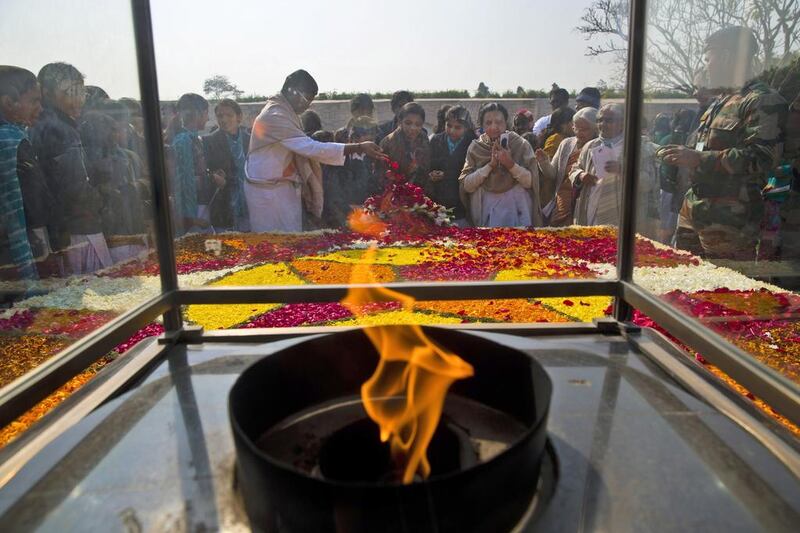NEW DELHI // On the evening of January 30, 1948, as Mahatma Gandhi walked to a prayer meeting in Delhi, he was shot and killed by an assassin who stepped out of the crowd and whipped out a revolver.
But on this year’s anniversary of his death, more attention is being paid to his killer, Nathuram Godse, who is being lionised by Hindu right-wing groups.
Godse, who said during his trial that he had shot Gandhi for his bias towards Muslims and his appeasement of the newly created Pakistan, was sentenced to death in November 1949 and hanged a week later. A co-conspirator was also hanged, while five others — including Godse’s brother Gopal — were sentenced to life in prison.
On Thursday, in the north Indian town of Meerut, authorities issued prohibitory orders to the Akhil Bharatiya Hindu Mahasabha (ABHM), which had planned to install a statue of Godse and build a temple in his honour.
An ABHM leader told The Hindu newspaper on Friday that he planned to convince temples across the region to install statues of Godse. "We do have statues of great Hindu reformers and great men in temple premises," he said.
Last month, Sakshi Maharaj, a parliamentarian from prime minister Narendra Modi’s Bharatiya Janata Party (BJP), called Godse “a nationalist”.
“He may have done something by mistake but was not an antinational. He was a patriot,” Mr Maharaj said.
The ABHM’s general secretary, Acharya Madan, said in December that Godse had killed “for a cause”, while the group’s president, Chander Prakash Kaushik, described him as “a patriot, freedom fighter, an editor, and not a criminal”.
“He’s a martyr and we want the people of this nation to know the truth that compelled Nathuram Godse to assassinate Gandhi,” Mr Kaushik told the news website Firstpost.
The ABHM has produced a film, Desh Bhakt Nathuram Godse (Patriot Nathuram Godse), although no release date has been given.
In October, in a Malayalam-language publication, the Rashtriya Swayamsevak Sangh — another Hindu nationalist group and the BJP’s ideological parent — praised Godse as well, saying that “he pulled the trigger on Gandhi’s chest after a respectful bow”.
"These groups are bolder now that they think their party is in power," the director of the National Gandhi Museum, A Annamalai, told The National, referring to the BJP. "They think they can push this agenda. It makes me terribly sad."
In response to the recent glorification of Godse, hundreds of people have taken part in a Facebook campaign, posting selfies holding placards with the words “#NoToGodse, #NoToHate”.
“One doesn’t have to believe in everything Gandhi stood for to denounce a mad hater like Godse and his worshippers,” Anusuya Datta, a New Delhi-based editor at the trade magazine Geospatial, wrote alongside her post.
Born in 1910, Godse grew up in the town of Pune, in Maharashtra, fervently admiring Gandhi, who at that time was just starting to spearhead the movement against British colonial rule.
After school, Godse became a volunteer with the Hindu Mahasabha — a precursor of the ABHM — and the RSS.
The RSS has always denied any connection with the assassination.
A former president of the Hindu Mahasabha, Vinayak Savarkar, was tried for complicity in the murder. Only one witness testified that Savarkar was involved, so he was acquitted.
In a letter written less than a month after the murder, Sardar Patel, the home minister at the time, said it was “a fanatical wing of the Hindu Mahasabha directly under Savarkar that [planned] the conspiracy and saw it through”.
The assassination, Patel wrote, was “welcomed by those in the RSS and the Mahasabha”.
Through the 1930s and 1940s, the Hindu right grew more and more incensed with what it saw as Gandhi’s concessions to the Muslim League, which later pressed successfully for the creation Pakistan.
When India was partitioned, religious riots broke out across the subcontinent. Gandhi went on a series of hunger strikes, imploring India’s Hindu majority to not slaughter Muslims. He also pushed for the new government, headed by Jawaharlal Nehru, to give Pakistan its remaining share of the treasury’s funds — a total of 550 million rupees at the time.
During his trial, Godse said that Gandhi “always showed or evinced a bias for Muslims, prejudicial and detrimental to the Hindu community and its interests” and “had to pay the penalty of his life for his unjust, antinational and dangerous favouritism”.
Mr Annamalai, the Gandhi museum director, said erecting statues of Godse would send the message that people should be divided, not united.
“But it is the diversity and plurality of India that we need to convey, not this divisiveness,” he said.
ssubramanian@thenational.ae





